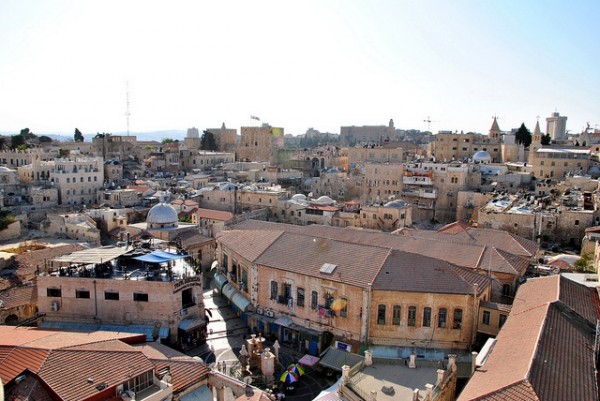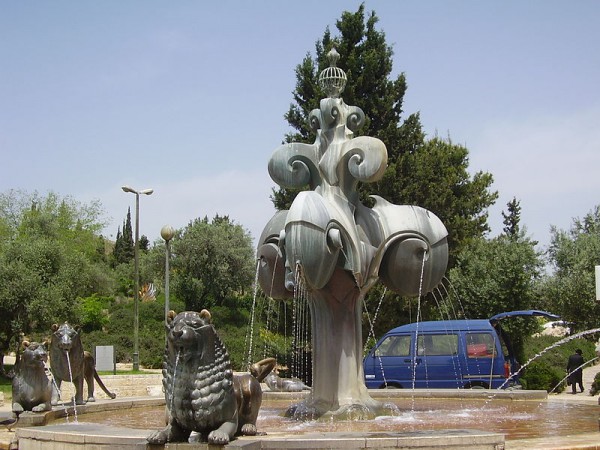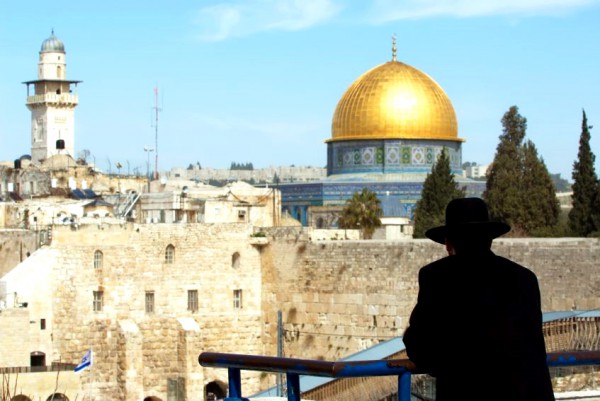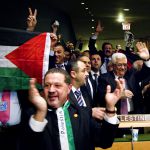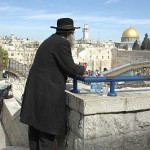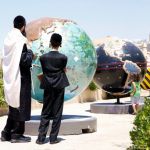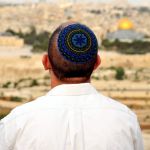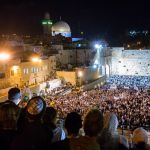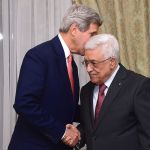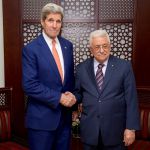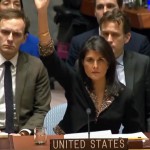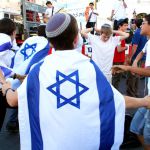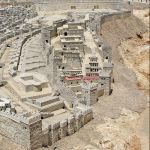“If I forget you, Jerusalem, may my right hand forget its skill. May my tongue cling to the roof of my mouth if I do not remember you, if I do not consider Jerusalem my highest joy.” (Psalm 137:5–6)
Last week, at the European Parliament plenary session in Strasbourg, European foreign policy chief Catherine Ashton said that Israel and Palestine must share Jerusalem “as part of any two state agreement.”

EU High Representative Catherine Ashton (right) with Middle East Quartet Special Envoy Tony Blair (left), U.S. Secretary of State Hillary Rodham Clinton, UN Secretary General Ban Ki-Moon (center), Russian Foreign Minister Sergey Lavrov (fourth from left) in the Secretary General’s Conference Room at the United Nations in New York. The Quartet, which is involved in mediating peace in the Israeli-Palestinian conflict, comprises the United Nations, the United States, the European Union, and Russia.
According to end-time prophecy, Jerusalem will play a major role in the last days (Zechariah 12:10, 14:10–11; Isaiah 62:1–3; Joel 3:20, etc.).
It should come as no surprise then that Jerusalem’s role as the capital of Israel remains in dispute despite more than 650 direct references to Jerusalem in the ancient Hebrew Bible, from which comes your translation today.
Jerusalem on the Chopping Block
“On the day you stood aloof while strangers carried off his wealth and foreigners entered his gates and cast lots for Jerusalem, you were like one of them. You should not gloat over your brother in the day of his misfortune, nor rejoice over the people of Judah in the day of their destruction, nor boast so much in the day of their trouble.” (Obadiah 1:11-12)
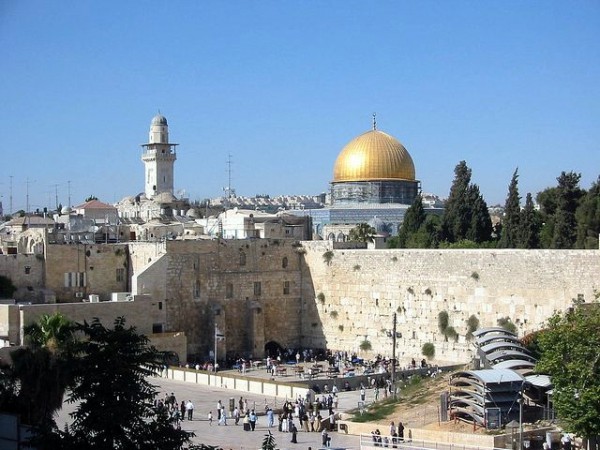
The Old City of Jerusalem is home to both Jewish and Islamic holy sites would end up on the Palestinian side and Islamic Holy sites on the Israeli side (Institute for Public Affairs).
Although Jerusalem is indisputably central to the historical and religious identity of the Jewish People, and although it’s mentioned daily by pupils singing the Israeli national anthem and in Jewish prayer all over the world, many so-called voices for peace have set Jerusalem on the chopping block.
Some argue that the physical division of Jerusalem would “improve the city’s demographic balance between Jews and Arabs in favor of Jews,” Israeli author and journalist Nadav Shragai stated in Jerusalem: The Dangers of Division— An Alternative to Separation from the Arab Neighborhoods.
However, a cookie-cutter division of Jerusalem is unworkable because of the city’s unique composition.
Jerusalem is a demographic tapestry where neighborhoods of Arabs and Jews, as well as international residents, coexist side by side. This tapestry is so intricately woven in places that it’s impossible to divide the city.
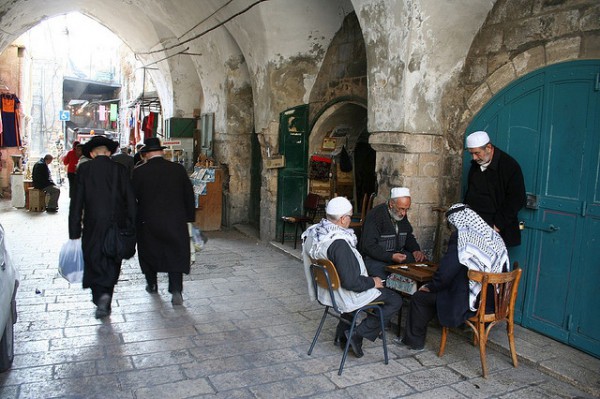
Jerusalem is a mosaic of Arabs and Jews. In many parts of Jerusalem, they coexist side by side peacefully. And it’s rare, but some Jews are even married to Palestinians.
For example, the Jerusalem Center for Public Affairs reported that Jerusalem’s population comprises 285,000 Arabs and more than half a million Jews.
Almost 39 percent of Jerusalem’s Jewish population lives in East Jerusalem— 194,000 Jews to East Jerusalem’s 272,000 Arabs.
In Jerusalem, Arabs and Jews cross into the other’s neighborhoods to go work and conduct their daily business.
They also use the same roads, electricity grids, gas pipelines and water systems; these complex networks serve all of Jerusalem’s residents.
The difficulty of a Jerusalem divided would be intensified by negotiating the usage and repair of the infrastructure that connects Arabs and Jews.
Sharing Water: One of Israel’s Most Valuable Resources
With 60 percent of Israel being classified as arid or semi-arid, water is one of Israel’s most valuable resources.
Since water has always been a source of political conflict in the Middle East, it’s not surprising that water issues are part of the conflict between Israel and the Palestinian Authority (PA).
Israel has honored its obligations to develop water resources under the Oslo II agreement, while the PA has neglected them by failing to build build pipes for the wells Israel has produced, and failing to repair “antiquated and corroded pipes which cause significant water losses.” (palestinefacts)
In PA controlled areas, water is stolen from water mains and sold to the thirsty. Meanwhile, rich Palestinians can fill their private swimming pools with water.
In Jerusalem, Arabs enjoy a potable water supply alongside their Jewish neighbors.
If Jerusalem were divided into two sovereign areas that necessarily share the infrastructure network, damage or pollution occurring in potentially neglected sections of the water system would directly affect the neighboring population.
In a divided Jerusalem, there would be no checks in place ensuring appropriate repairs or consistent sanitation.
As it stands now, Israel is equipped to make certain these networks are working properly and are compliant with health regulations. Israel’s stable, thriving economy ensures sufficient finances to maintain the infrastructure.
It’s no wonder that the prospect of a divided Jerusalem has sent “a wave of tens of thousands of Palestinians moving to the ‘Israeli side’ of Jerusalem (Shragai).”
Many Palestinians have filed for Israeli citizenship, despite considerable pressure from the West Bank not to. (City Journal)
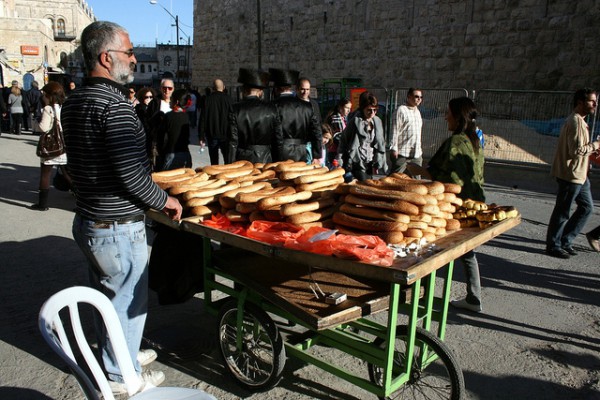
An Arab bread seller in the Old City of Jerusalem displays his products to the Arab and Jewish public walking by.
Priority Number One: Peace Coexistence between Israel and the PA
“The Lord builds up Jerusalem; He gathers the exiles of Israel.” (Psalm 147:2)
In order for a division of Jerusalem to work between Israel and the Palestinian Authority (PA), there must first be a peace agreement.
So far, however, there has been little movement in that direction.
The PA was demonstratively weak in reclaiming Gaza from Hamas control in June 2007, thus enabling the continuation of terrorist attacks against Israel.
Furthermore, the dissemination of anti-Israel textbooks in Palestinian schools has effectively ensured that mistrust and hatred of Israel has taken root in the next generation of Palestinians.
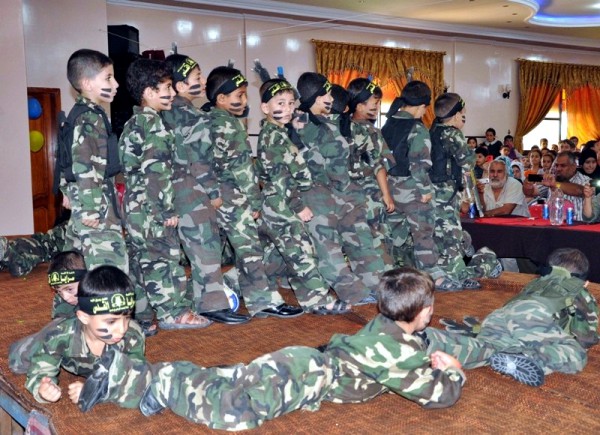
Islamic Jihad’s website recently posted a photo essay of Gaza kindergarten graduation ceremonies that promoted hatred of Israel and martyrdom.
The picture is no different in Gaza.
Recently, at a kindergarten graduation in Gaza, Palestinian children celebrated by dressing up as Jewish and Palestinian soldiers, waving rifles, and shouting anti-Israel slogans.
The children dressed as Israeli soldiers demonstrated how they have been taught that Palestinians are tortured by dunking the heads of their victims in pails of water.
The children also stood beside mock coffins draped with flags bearing the images of “shahids” (martyrs).
One child said, “When I grow up I’ll join Islamic Jihad and the al-Quds Brigades. I’ll fight the Zionist enemy and fire missiles at it until I die as a shahid and join my father in heaven.
“I love the resistance and the martyrs and Palestine, and I want to blow myself up on Zionists and kill them on a bus in a suicide bombing.” (Ynet)
The fanatic Muslim kindergarten director of this Islamic-Jihad run school said: “It is our obligation to educate the children to love the resistance, Palestine and Jerusalem, so they will recognize the importance of Palestine and
who its enemy is.”
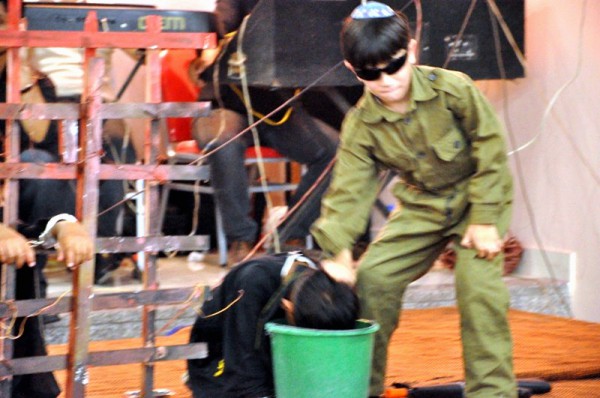
A Palestinian kindergarten student dressed as an Israeli soldier tortures his ‘Palestinian victim’ in a graduation ceremony that glorified violence and hatred of Israel.
The founder and director of the Palestinian Media Watch, Itamar Marcus, recently said that there is little difference between schools in Gaza and the PA-controlled West Bank.
“There are nuances between the programs, but the messages are the same – Israel has no right to exist or simply doesn’t exist,” he said.
Dr. Dan Shiftan, who is the head of the National Security Studies Centre at the University of Haifa said this fascination with terror represented “a deep problem with the entire Palestinian society,” which is locked in a victim mentality and unwilling “to accept responsibility for their suffering.” (Ynet)
This February, the Palestinian Authority pushed further away from peaceful relations with Israel, committing to an interim unity government with Hamas.
The Hamas charter states that “Israel will exist and will continue to exist until Islam will obliterate it.” It has backed this up with thousands of missile attacks and other acts of violence against Israel.
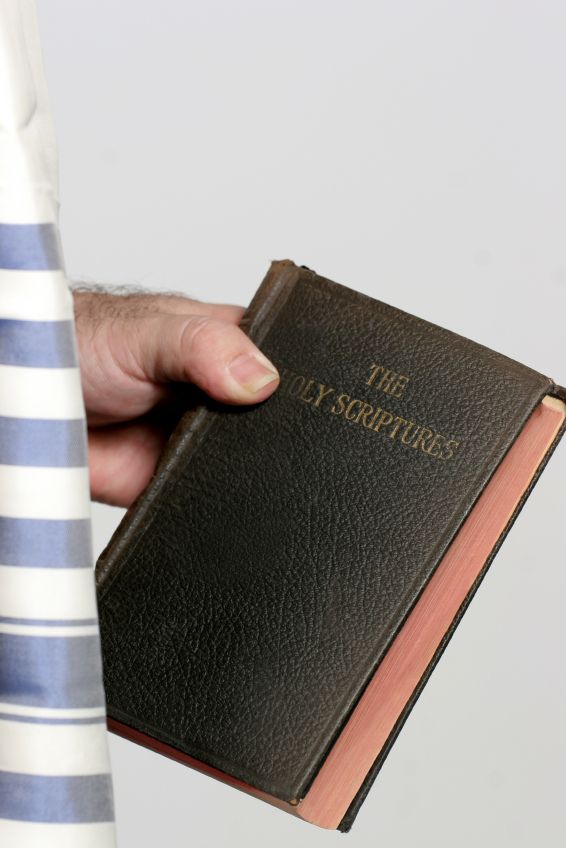
“You will arise and have compassion on Zion, for it is time to show favor to her; the appointed time has come.” (Psalm 102:13)
A Divided Jerusalem: No Peace at All
“I am going to make Jerusalem a cup that sends all the surrounding peoples reeling. Judah will be besieged as well as Jerusalem.” (Zechariah 12:2)
If Jerusalem were divided, its Arab neighborhoods would become a part of Palestine while the Jewish neighborhoods would remain a part of Israel.
That line of separation would become the new border between the State of Israel and the new country of the Palestinian Authority.
While physically divvying up Arab and Jewish neighborhoods would be straightforward to some extent in some areas of Jerusalem, other areas would be problematic.
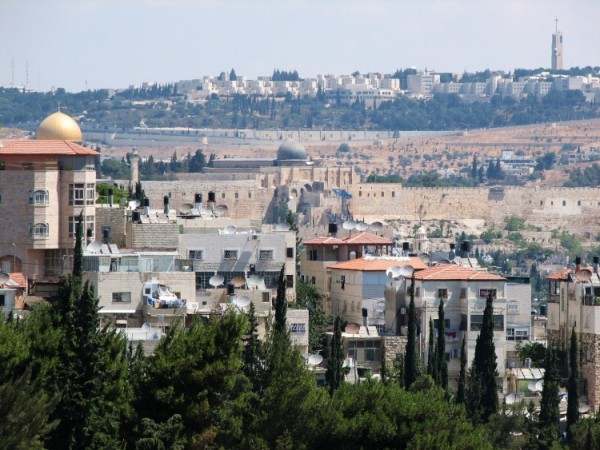
In the neighborhood of Abu Tor in Jerusalem, an Arab and a Jewish neighborhood closely border each other.
American journalist Michael Totten took a walk last year through one of those areas and wrote the following:
Take the neighborhood of Abu Tor, on a hill just south of the Old City. [Our Bible Ministry once had offices there].
The eastern side is Arab, and the western side is Jewish. The Green Line runs through its center. It would be easy enough, theoretically, to make the Green Line the border between Israel and a Palestinian state.
But that border would go right down the middle of a street where Jews live on one side and Arabs live on the other. If a wall or a fence were erected on that border, residents wouldn’t be able to drive down their own street.
And if there were no wall or a fence, anyone could cross the border without passing through customs or security: tourists, spies, job-seekers, and suicide bombers. A Palestinian could throw a hand grenade into Israel from inside his living room, and vice versa. (City Journal)
Just imagine your children living in such a hostile environment!
And yet, Palestinian negotiators insist that Jerusalem must be divided in any peace agreement.
That kind of peace agreement is unworkable.
We encourage you to keep Jerusalem in your prayers, as only God can bring true peace to this region.
Whatever happens in Jerusalem has deep significance for the entire world. This is the Holy City to which Yeshua (Jesus) will soon return.
“Pray for the peace of Jerusalem: ‘May those who love you be secure.’” (Psalm 122:6)




